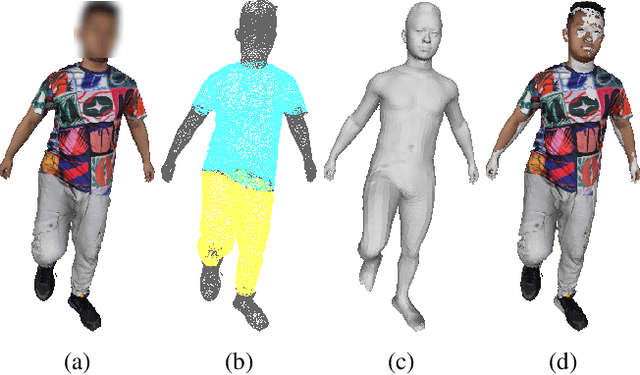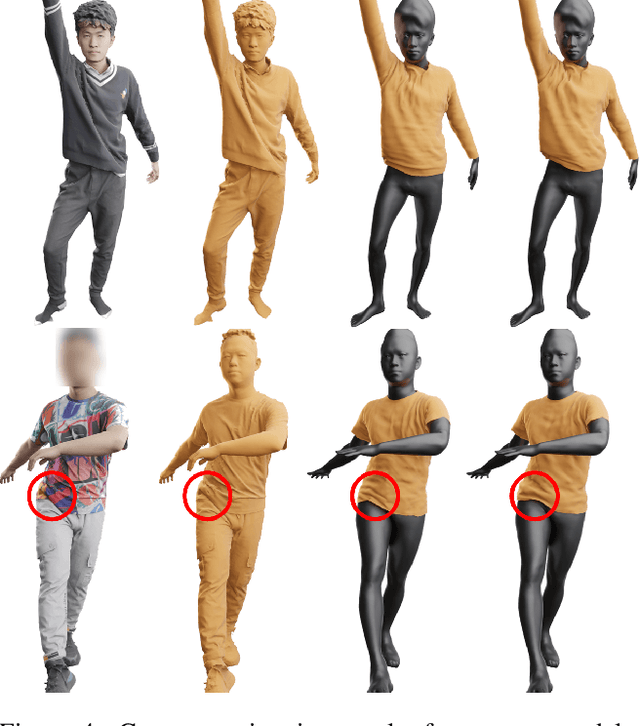Liangxiao Hu
GaussianAvatar: Towards Realistic Human Avatar Modeling from a Single Video via Animatable 3D Gaussians
Dec 04, 2023



Abstract:We present GaussianAvatar, an efficient approach to creating realistic human avatars with dynamic 3D appearances from a single video. We start by introducing animatable 3D Gaussians to explicitly represent humans in various poses and clothing styles. Such an explicit and animatable representation can fuse 3D appearances more efficiently and consistently from 2D observations. Our representation is further augmented with dynamic properties to support pose-dependent appearance modeling, where a dynamic appearance network along with an optimizable feature tensor is designed to learn the motion-to-appearance mapping. Moreover, by leveraging the differentiable motion condition, our method enables a joint optimization of motions and appearances during avatar modeling, which helps to tackle the long-standing issue of inaccurate motion estimation in monocular settings. The efficacy of GaussianAvatar is validated on both the public dataset and our collected dataset, demonstrating its superior performances in terms of appearance quality and rendering efficiency.
CaPhy: Capturing Physical Properties for Animatable Human Avatars
Aug 11, 2023



Abstract:We present CaPhy, a novel method for reconstructing animatable human avatars with realistic dynamic properties for clothing. Specifically, we aim for capturing the geometric and physical properties of the clothing from real observations. This allows us to apply novel poses to the human avatar with physically correct deformations and wrinkles of the clothing. To this end, we combine unsupervised training with physics-based losses and 3D-supervised training using scanned data to reconstruct a dynamic model of clothing that is physically realistic and conforms to the human scans. We also optimize the physical parameters of the underlying physical model from the scans by introducing gradient constraints of the physics-based losses. In contrast to previous work on 3D avatar reconstruction, our method is able to generalize to novel poses with realistic dynamic cloth deformations. Experiments on several subjects demonstrate that our method can estimate the physical properties of the garments, resulting in superior quantitative and qualitative results compared with previous methods.
Real-time Monocular Full-body Capture in World Space via Sequential Proxy-to-Motion Learning
Jul 03, 2023



Abstract:Learning-based approaches to monocular motion capture have recently shown promising results by learning to regress in a data-driven manner. However, due to the challenges in data collection and network designs, it remains challenging for existing solutions to achieve real-time full-body capture while being accurate in world space. In this work, we contribute a sequential proxy-to-motion learning scheme together with a proxy dataset of 2D skeleton sequences and 3D rotational motions in world space. Such proxy data enables us to build a learning-based network with accurate full-body supervision while also mitigating the generalization issues. For more accurate and physically plausible predictions, a contact-aware neural motion descent module is proposed in our network so that it can be aware of foot-ground contact and motion misalignment with the proxy observations. Additionally, we share the body-hand context information in our network for more compatible wrist poses recovery with the full-body model. With the proposed learning-based solution, we demonstrate the first real-time monocular full-body capture system with plausible foot-ground contact in world space. More video results can be found at our project page: https://liuyebin.com/proxycap.
 Add to Chrome
Add to Chrome Add to Firefox
Add to Firefox Add to Edge
Add to Edge